
Stress (physics)
Encyclopedia
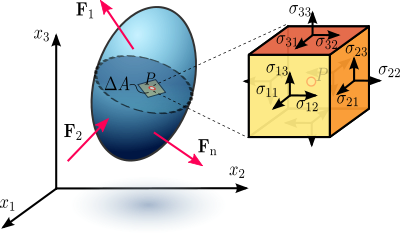
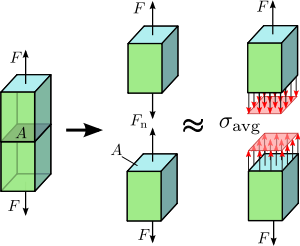
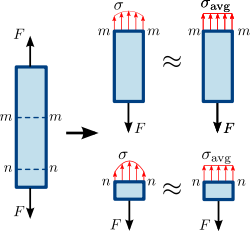
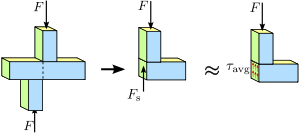
Continuum mechanics
Continuum mechanics is a branch of mechanics that deals with the analysis of the kinematics and the mechanical behavior of materials modelled as a continuous mass rather than as discrete particles...
, stress is a measure of the internal force
Force
In physics, a force is any influence that causes an object to undergo a change in speed, a change in direction, or a change in shape. In other words, a force is that which can cause an object with mass to change its velocity , i.e., to accelerate, or which can cause a flexible object to deform...
s acting within a deformable body. Quantitatively, it is a measure of the average force per unit area
Area
Area is a quantity that expresses the extent of a two-dimensional surface or shape in the plane. Area can be understood as the amount of material with a given thickness that would be necessary to fashion a model of the shape, or the amount of paint necessary to cover the surface with a single coat...
of a surface within the body on which internal forces act. These internal forces are a reaction to external forces applied on the body. Because the loaded deformable body is assumed to behave as a continuum
Continuum (theory)
Continuum theories or models explain variation as involving a gradual quantitative transition without abrupt changes or discontinuities. It can be contrasted with 'categorical' models which propose qualitatively different states.-In physics:...
, these internal forces are distributed continuously within the volume of the material body, and result in deformation
Deformation (mechanics)
Deformation in continuum mechanics is the transformation of a body from a reference configuration to a current configuration. A configuration is a set containing the positions of all particles of the body...
of the body's shape. Beyond certain limits of material strength
Strength of materials
In materials science, the strength of a material is its ability to withstand an applied stress without failure. The applied stress may be tensile, compressive, or shear. Strength of materials is a subject which deals with loads, deformations and the forces acting on a material. A load applied to a...
, this can lead to a permanent shape change or structural failure.
The dimension of stress is that of pressure
Pressure
Pressure is the force per unit area applied in a direction perpendicular to the surface of an object. Gauge pressure is the pressure relative to the local atmospheric or ambient pressure.- Definition :...
, and therefore the SI
International System of Units
The International System of Units is the modern form of the metric system and is generally a system of units of measurement devised around seven base units and the convenience of the number ten. The older metric system included several groups of units...
unit for stress is the pascal
Pascal (unit)
The pascal is the SI derived unit of pressure, internal pressure, stress, Young's modulus and tensile strength, named after the French mathematician, physicist, inventor, writer, and philosopher Blaise Pascal. It is a measure of force per unit area, defined as one newton per square metre...
(symbol Pa), which is equivalent to one newton (force) per square meter (unit area), that is N/m2. In Imperial units, stress is measured in pound-force
Pound-force
The pound force is a unit of force in some systems of measurement including English engineering units and British gravitational units.- Definitions :...
per square inch
Inch
An inch is the name of a unit of length in a number of different systems, including Imperial units, and United States customary units. There are 36 inches in a yard and 12 inches in a foot...
, which is abbreviated as psi.
Introduction
"Stress" measures the average force per unit area of a surface within a deformable body on which internal forces act, specifically the intensity of the internal forces acting between particles of a deformable body across imaginary internal surfaces. These internal forces are produced between the particles in the body as a reaction to external forces. External forces are either surface forceSurface force
Surface force denoted fs is the force that acts across an internal or external surface element in a material body. Surface force can be decomposed in to two perpendicular components: pressure and stress forces....
s or body force
Body force
A body force is a force that acts throughout the volume of a body, in contrast to contact forces.Gravity and electromagnetic forces are examples of body forces. Centrifugal and Coriolis forces can also be viewed as body forces.This can be put into contrast to the classical definition of surface...
s. Because the loaded deformable body is assumed to behave as a continuum, these internal forces are distributed continuously within the volume of the material body, i.e. the stress distribution in the body is expressed as a piecewise
Piecewise
On mathematics, a piecewise-defined function is a function whose definition changes depending on the value of the independent variable...
continuous function
Continuous function
In mathematics, a continuous function is a function for which, intuitively, "small" changes in the input result in "small" changes in the output. Otherwise, a function is said to be "discontinuous". A continuous function with a continuous inverse function is called "bicontinuous".Continuity of...
of space and time.
Normal stress
For the simple case of an axially loaded body, e.g., a bar subjected to tension or compression by a force passing through its center (Figures 1.2 and 1.3) the stress (sigma), or intensity of internal forces, can be obtained by dividing the total normal force
(sigma), or intensity of internal forces, can be obtained by dividing the total normal force  by the bar's cross-sectional area
by the bar's cross-sectional area  . In the case of a prismatic bar axially loaded, the stress
. In the case of a prismatic bar axially loaded, the stress  is represented by a scalar
is represented by a scalarScalar (physics)
In physics, a scalar is a simple physical quantity that is not changed by coordinate system rotations or translations , or by Lorentz transformations or space-time translations . This is in contrast to a vector...
called engineering stress or nominal stress that represents an average stress (
 ) over the area, meaning that the stress in the cross-section is uniformly distributed. Thus, we have
) over the area, meaning that the stress in the cross-section is uniformly distributed. Thus, we have .
.The normal force can be a tensile force if acting outward from the plane, or compressive force if acting inward to the plane.
Normal stress can be caused by several loading methods, the most common being axial tension and compression, bending, and hoop stress. For the case of axial tension or compression (Figure 1.3), the normal stress is observed in two planes
 and
and  of the axially loaded prismatic bar. The stress on plane
of the axially loaded prismatic bar. The stress on planePlane
-Physical objects:* Aeroplane or airplane, a fixed-wing aircraft* Plane , a woodworking tool to smooth surfaces* Platanus, a genus of trees with the common name "plane"* Acer pseudoplatanus, a tree species sometimes called "plane"...
 , which is closer to the point of application of the load
, which is closer to the point of application of the load  , varies more across the cross-section than that of plane
, varies more across the cross-section than that of plane  . However, if the cross-sectional area of the bar is very small, i.e. the bar is slender, the variation of stress across the area is small and the normal stress can be approximated by
. However, if the cross-sectional area of the bar is very small, i.e. the bar is slender, the variation of stress across the area is small and the normal stress can be approximated by  . On the other hand, the variation of shear stress across the section of a prismatic bar cannot be assumed to be uniform.
. On the other hand, the variation of shear stress across the section of a prismatic bar cannot be assumed to be uniform.In the case of bending of a bar (Figure ???), one side is stretched and the other compressed, resulting in axial tensile and compressive normal stresses on the respective sides.
Hoop stress (Figure ???) is typically seen in pressure vessels, where internal pressure causes the vessel walls to expand, which results in tensile normal stress.
Shear stress
A different type of stress occurs when the force occurs in shear, as shown in Figure 1.4.
occurs in shear, as shown in Figure 1.4.  is called the shear force. Dividing the shear force
is called the shear force. Dividing the shear force  by the cross-sectional area
by the cross-sectional area  we obtain the shear stress
we obtain the shear stress  (tau).
(tau).
Shear stress can also be caused by various loading methods, including direct shear, torsion, and can be significant in bending. A shaft loaded in torsion sees shear stress in the direction tangential to its axis. I-beams see significant shear in the web under bending loads; this is due to the web constraining the flanges.
Combined stresses
Often, mechanical bodies experience more than one type of stress at the same time; this is called combined stress. When two or more stress act on one plane, ie bending and shear, this is called biaxial stress. For combined stresses that act in all directions, ie bending, torque, and pressure, this is triaxial stress. Various methods for handling combined stresses are included in this article.Stress modeling (Cauchy)
Stress is generally not uniformly distributed over the cross-section of a material body. Consequently the stress at a given point differs from the average stress over the entire area. Therefore it is necessary to define the stress a specific point in the body (Figure 1.1). According to Cauchy, the stress at any point in an object, assumed to behave as a continuum, is completely defined by nine component stresses: three orthogonal normal stresses and six orthogonal shear stresses. This can be expressed as a second-order tensorTensor
Tensors are geometric objects that describe linear relations between vectors, scalars, and other tensors. Elementary examples include the dot product, the cross product, and linear maps. Vectors and scalars themselves are also tensors. A tensor can be represented as a multi-dimensional array of...
of type (0,2) known as the Cauchy stress tensor,
 :
:
The Cauchy stress tensor obeys the tensor transformation law under a change in the system of coordinates. A graphical representation of this transformation law is the Mohr's circle of stress distribution. Certain invariants are associated with the stress tensor, whose values do not depend upon the coordinate system chosen or the area element upon which the stress tensor operates. These are the three eigenvalues of the stress tensor, which are called the principal stresses.
The Cauchy stress tensor is used for stress analysis of material bodies experiencing small deformations where the differences in stress distribution in most cases can be neglected. For large deformations, also called finite deformations, other measures of stress, such as the first and second Piola–Kirchhoff stress tensors, the Biot stress tensor
Stress measures
The most commonly used measure of stress is the Cauchy stress. However, several other measures of stress can be defined. Some such stress measures that are widely used in continuum mechanics, particularly in the computational context, are:...
, and the Kirchhoff stress tensor
Stress measures
The most commonly used measure of stress is the Cauchy stress. However, several other measures of stress can be defined. Some such stress measures that are widely used in continuum mechanics, particularly in the computational context, are:...
, are required.
According to the principle of conservation of linear momentum, if a continuous body is in static equilibrium it can be demonstrated that the components of the Cauchy stress tensor at every material point in the body satisfy the equilibrium equations (Cauchy’s equations of motion for zero acceleration). At the same time, according to the principle of conservation of angular momentum, equilibrium requires that the summation of moments
Torque
Torque, moment or moment of force , is the tendency of a force to rotate an object about an axis, fulcrum, or pivot. Just as a force is a push or a pull, a torque can be thought of as a twist....
with respect to an arbitrary point is zero, which leads to the conclusion that the stress tensor is symmetric, thus having only six independent stress components instead of the original nine.
Solids, liquids, and gases have stress field
Stress field
A stress field is a region in a body for which the stress is defined at every point. Stress fields are widely used in fluid dynamics and materials science....
s. Static fluids support normal stress but will flow under shear stress
Shear stress
A shear stress, denoted \tau\, , is defined as the component of stress coplanar with a material cross section. Shear stress arises from the force vector component parallel to the cross section...
. Moving viscous fluids
Viscosity
Viscosity is a measure of the resistance of a fluid which is being deformed by either shear or tensile stress. In everyday terms , viscosity is "thickness" or "internal friction". Thus, water is "thin", having a lower viscosity, while honey is "thick", having a higher viscosity...
can support shear stress (dynamic pressure). Solids can support both shear and normal stress, with ductile materials failing under shear and brittle
Brittle
A material is brittle if, when subjected to stress, it breaks without significant deformation . Brittle materials absorb relatively little energy prior to fracture, even those of high strength. Breaking is often accompanied by a snapping sound. Brittle materials include most ceramics and glasses ...
materials failing under normal stress. All materials have temperature dependent variations in stress-related properties, and non-Newtonian
Non-Newtonian fluid
A non-Newtonian fluid is a fluid whose flow properties differ in any way from those of Newtonian fluids. Most commonly the viscosity of non-Newtonian fluids is not independent of shear rate or shear rate history...
materials have rate-dependent variations.
Stress analysis
Stress analysisStress analysis
Stress analysis is an engineering discipline that determines the stress in materials and structures subjected to static or dynamic forces or loads. A stress analysis is required for the study and design of structures, e.g., tunnels, dams, mechanical parts, and structural frames among others, under...
is the determination of the internal distribution of stresses in a structure. It is needed in engineering
Engineering
Engineering is the discipline, art, skill and profession of acquiring and applying scientific, mathematical, economic, social, and practical knowledge, in order to design and build structures, machines, devices, systems, materials and processes that safely realize improvements to the lives of...
for the study and design of structures such as tunnels, dams, mechanical parts, and structural frames, under prescribed or expected loads. To determine the distribution of stress in a structure, the engineer needs to solve a boundary-value problem by specifying the boundary conditions. These are displacements and forces on the boundary of the structure.
Constitutive equations, such as Hooke’s law for linear elastic
Linear elasticity
Linear elasticity is the mathematical study of how solid objects deform and become internally stressed due to prescribed loading conditions. Linear elasticity models materials as continua. Linear elasticity is a simplification of the more general nonlinear theory of elasticity and is a branch of...
materials, describe the stress-strain relationship in these calculations.
When a structure is expected to deform elastically (and resume its original shape), a boundary-value problem based on the theory of elasticity is applied, with infinitesimal strains, under design loads.
When the applied loads permanently deform the structure, the theory of plasticity
Plasticity (physics)
In physics and materials science, plasticity describes the deformation of a material undergoing non-reversible changes of shape in response to applied forces. For example, a solid piece of metal being bent or pounded into a new shape displays plasticity as permanent changes occur within the...
applies.
Stress analysis is simplified when the physical dimensions and the distribution of loads allow the structure to be treated as one- or two-dimensional. For a two-dimensional analysis a plane stress or a plane strain condition can be assumed. Alternatively, stresses can be experimentally determined.
Computer-based approximations for boundary-value problems can be obtained through numerical methods such as the finite element method
Finite element method
The finite element method is a numerical technique for finding approximate solutions of partial differential equations as well as integral equations...
, the finite difference method
Finite difference method
In mathematics, finite-difference methods are numerical methods for approximating the solutions to differential equations using finite difference equations to approximate derivatives.- Derivation from Taylor's polynomial :...
, and the boundary element method
Boundary element method
The boundary element method is a numerical computational method of solving linear partial differential equations which have been formulated as integral equations . It can be applied in many areas of engineering and science including fluid mechanics, acoustics, electromagnetics, and fracture...
. Analytical or closed-form solutions can be obtained for simple geometries, constitutive relations, and boundary conditions.
Theoretical background
Continuum mechanics deals with deformable bodies, as opposed to rigid bodies. The stresses considered in continuum mechanics are only those produced by deformation of the body, sc. relative changes are considered rather than absolute values. A body is considered stress-free if the only forces present are those inter-atomic forces (ionicIonic bond
An ionic bond is a type of chemical bond formed through an electrostatic attraction between two oppositely charged ions. Ionic bonds are formed between a cation, which is usually a metal, and an anion, which is usually a nonmetal. Pure ionic bonding cannot exist: all ionic compounds have some...
, metallic
Metallic bond
Metallic bonding is the electrostatic attractive forces between the delocalized electrons, called conduction electrons, gathered in an "electron sea", and the positively charged metal ions...
, and van der Waals force
Van der Waals force
In physical chemistry, the van der Waals force , named after Dutch scientist Johannes Diderik van der Waals, is the sum of the attractive or repulsive forces between molecules other than those due to covalent bonds or to the electrostatic interaction of ions with one another or with neutral...
s) required to hold the body together and to keep its shape in the absence of all external influences, including gravitational attraction. Stresses generated during manufacture of the body to a specific configuration are also excluded.
Following classical Newtonian
Isaac Newton
Sir Isaac Newton PRS was an English physicist, mathematician, astronomer, natural philosopher, alchemist, and theologian, who has been "considered by many to be the greatest and most influential scientist who ever lived."...
and Eulerian
Leonhard Euler
Leonhard Euler was a pioneering Swiss mathematician and physicist. He made important discoveries in fields as diverse as infinitesimal calculus and graph theory. He also introduced much of the modern mathematical terminology and notation, particularly for mathematical analysis, such as the notion...
dynamics, the motion of a material body is produced by the action of externally applied forces which are assumed to be of two kinds: surface forces and body forces.
Surface forces, or contact forces, can act either on the bounding surface of the body, as a result of mechanical contact with other bodies, or on imaginary internal surfaces that bind portions of the body, as a result of the mechanical interaction between the parts of the body to either side of the surface (#Euler–Cauchy's stress principle). When external contact forces act on a body, internal contact forces pass from point to point inside the body to balance their action, according to Newton's second law of motion
Newton's laws of motion
Newton's laws of motion are three physical laws that form the basis for classical mechanics. They describe the relationship between the forces acting on a body and its motion due to those forces...
of conservation of linear momentum and angular momentum
Angular momentum
In physics, angular momentum, moment of momentum, or rotational momentum is a conserved vector quantity that can be used to describe the overall state of a physical system...
. These laws are called Euler's equations of motion
Euler's laws
Euler's laws of motion, formulated by Leonhard Euler about 50 years after Isaac Newton formulated his laws about the motion of particles, extends them to rigid body motion.-Euler's first law:...
for continuous bodies. The internal contact forces are related to the body's deformation through constitutive equations. This article provides mathematical descriptions of internal contact forces and how they relate to the body's motion, independent of the body's material makeup.
Stress can be thought as a measure of the internal contact forces' intensity acting between particles of the body across imaginary internal surfaces. In other words, stress is a measure of the average quantity of force exerted per unit area of the surface on which these internal forces act. The intensity of contact forces is in inverse proportion to the contact area. For example, if a force applied to a small area is compared to a distributed load of the same resultant magnitude applied to a larger area, one finds that the effects or intensities of these two forces are locally different because the stresses are not the same.
Body forces originate from sources outside of the body that act on its volume (or mass). This implies that the internal forces manifest through the contact forces alone. These forces arise from the presence of the body in force fields, (e.g., a gravitational field
Gravitational field
The gravitational field is a model used in physics to explain the existence of gravity. In its original concept, gravity was a force between point masses...
). As the mass of a continuous body is assumed to be continuously distributed, any force originating from the mass is also continuously distributed. Thus, body forces are assumed to be continuous over the body's volume.
The density of internal forces at every point in a deformable body is not necessarily even, i.e. there is a distribution of stresses. This variation of internal forces is governed by the laws of conservation of linear and angular momentum, which normally apply to a mass particle but extend in continuum mechanics to a body of continuously distributed mass. If a body is represented as an assemblage of discrete particles, each governed by Newton’s laws of motion, then Euler’s equations can be derived from Newton’s laws. Euler’s equations can, however, be taken as axioms describing the laws of motion for extended bodies, independently of any particle structure.
Euler–Cauchy stress principle
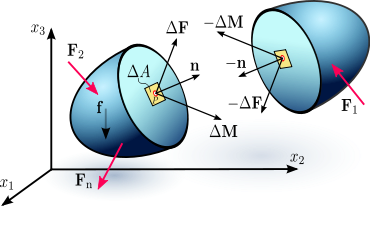
The Euler–Cauchy stress principle states that upon any surface (real or imaginary) that divides the body, the action of one part of the body on the other is equivalent (equipollent) to the system of distributed forces and couples on the surface dividing the body, and it is represented by a vector field T(n), called the stress vector, defined on the surface S and assumed to depend continuously on the surface's unit vector n.
To explain this principle, consider an imaginary surface S passing through an internal material point P dividing the continuous body into two segments, as seen in Figure 2.1a or 2.1b (some authors use the cutting plane diagram and others use the diagram with the arbitrary volume inside the continuum enclosed by the surface S). The body is subjected to external surface forces F and body forces b. The internal contact forces transmitted from one segment to the other through the dividing plane, due to the action of one portion of the continuum onto the other, generate a force distribution on a small area ΔS, with a normal unit vector n, on the dividing plane S. The force distribution is equipollent to a contact force ΔF and a couple stress ΔM, as shown in Figure 2.1a and 2.1b. Cauchy’s stress principle asserts that as ΔS becomes very small and tends to zero the ratio ΔF/ΔS becomes dF/dS and the couple stress vector ΔM vanishes. In specific fields of continuum mechanics the couple stress is assumed not to vanish; however, classical branches of continuum mechanics address non-polar
Polarity
In physics, polarity is a description of an attribute, typically a binary attribute , or a vector . For example:* An electric charge has a polarity of either positive or negative....
materials which do not consider couple stresses and body moments. The resultant vector dF/dS is defined as the stress vector or traction vector given by T(n) = Ti(n) ei at the point P associated with a plane with a normal vector n:

This equation means that the stress vector depends on its location in the body and the orientation of the plane on which it is acting.
Depending on the orientation of the plane under consideration, the stress vector may not necessarily be perpendicular to that plane, i.e. parallel to n, and can be resolved into two components:
- one normal to the plane, called normal stress

- where dFn is the normal component of the force dF to the differential area dS
- and the other parallel to this plane, called the shear stress

- where dFs is the tangential component of the force dF to the differential surface area dS. The shear stress can be further decomposed into two mutually perpendicular vectors.
Cauchy’s postulate
According to the Cauchy Postulate, the stress vector T(n) remains unchanged for all surfaces passing through the point P and having the same normal vector n at P, i.e., having a common tangentTangent
In geometry, the tangent line to a plane curve at a given point is the straight line that "just touches" the curve at that point. More precisely, a straight line is said to be a tangent of a curve at a point on the curve if the line passes through the point on the curve and has slope where f...
at P. This means that the stress vector is a function of the normal vector n only, and is not influenced by the curvature of the internal surfaces.
Cauchy’s fundamental lemma
A consequence of Cauchy’s postulate is Cauchy’s Fundamental Lemma, also called the Cauchy reciprocal theorem, which states that the stress vectors acting on opposite sides of the same surface are equal in magnitude and opposite in direction. Cauchy’s fundamental lemma is equivalent to Newton's third lawNewton's laws of motion
Newton's laws of motion are three physical laws that form the basis for classical mechanics. They describe the relationship between the forces acting on a body and its motion due to those forces...
of motion of action and reaction, and is expressed as

Cauchy’s stress theorem—stress tensor
The state of stress at a point in the body is then defined by all the stress vectors T(n) associated with all planes (infinite in number) that pass through that point. However, according to Cauchy’s fundamental theorem, also called Cauchy’s stress theorem, merely by knowing the stress vectors on three mutually perpendicular planes, the stress vector on any other plane passing through that point can be found through coordinate transformation equations.Cauchy’s stress theorem states that there exists a second-order tensor field
Tensor field
In mathematics, physics and engineering, a tensor field assigns a tensor to each point of a mathematical space . Tensor fields are used in differential geometry, algebraic geometry, general relativity, in the analysis of stress and strain in materials, and in numerous applications in the physical...
σ(x, t), called the Cauchy stress tensor, independent of n, such that T is a linear function of n:

This equation implies that the stress vector T(n) at any point P in a continuum associated with a plane with normal unit vector n can be expressed as a function of the stress vectors on the planes perpendicular to the coordinate axes, i.e. in terms of the components σij of the stress tensor σ.
To prove this expression, consider a tetrahedron
Tetrahedron
In geometry, a tetrahedron is a polyhedron composed of four triangular faces, three of which meet at each vertex. A regular tetrahedron is one in which the four triangles are regular, or "equilateral", and is one of the Platonic solids...
with three faces oriented in the coordinate planes, and with an infinitesimal area dA oriented in an arbitrary direction specified by a normal unit vector n (Figure 2.2). The tetrahedron is formed by slicing the infinitesimal element along an arbitrary plane n. The stress vector on this plane is denoted by T(n). The stress vectors acting on the faces of the tetrahedron are denoted as T(e1), T(e2), and T(e3), and are by definition the components σij of the stress tensor σ. This tetrahedron is sometimes called the Cauchy tetrahedron. The equilibrium of forces, i.e. Euler’s first law of motion (Newton’s second law of motion), gives:

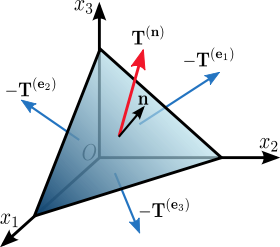



and then substituting into the equation to cancel out dA:

To consider the limiting case as the tetrahedron shrinks to a point, h must go to 0 (intuitively, the plane n is translated along n toward O). As a result, the right-hand-side of the equation approaches 0, so

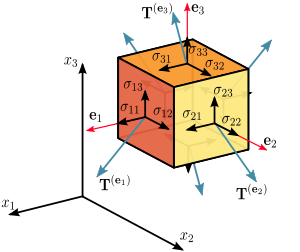



In index notation this is

The nine components σij of the stress vectors are the components of a second-order Cartesian tensor called the Cauchy stress tensor, which completely defines the state of stress at a point and is given by

where σ11, σ22, and σ33 are normal stresses, and σ12, σ13, σ21, σ23, σ31, and σ32 are shear stresses. The first index i indicates that the stress acts on a plane normal to the xi-axis, and the second index j denotes the direction in which the stress acts. A stress component is positive if it acts in the positive direction of the coordinate axes, and if the plane where it acts has an outward normal vector pointing in the positive coordinate direction.
Thus, using the components of the stress tensor

or, equivalently,

Alternatively, in matrix form we have

The Voigt notation
Voigt notation
In mathematics, Voigt notation or Voigt form in multilinear algebra is a way to represent a symmetric tensor by reducing its order. There are a few variants and associated names for this idea: Mandel notation, Mandel–Voigt notation and Nye notation are others found. Kelvin notation is a revival by...
representation of the Cauchy stress tensor takes advantage of the symmetry
Symmetry
Symmetry generally conveys two primary meanings. The first is an imprecise sense of harmonious or aesthetically pleasing proportionality and balance; such that it reflects beauty or perfection...
of the stress tensor to express the stress as a six-dimensional vector of the form:

The Voigt notation is used extensively in representing stress-strain relations in solid mechanics and for computational efficiency in numerical structural mechanics software.
Transformation rule of the stress tensor
It can be shown that the stress tensor is a contravariant second order tensor, which is a statement of how it transforms under a change of the coordinate system. From an xi-system to an xi'-system, the components σij in the initial system are transformed into the components σij' in the new system according to the tensor transformation rule (Figure 2.4):
where A is a rotation matrix with components aij. In matrix form this is

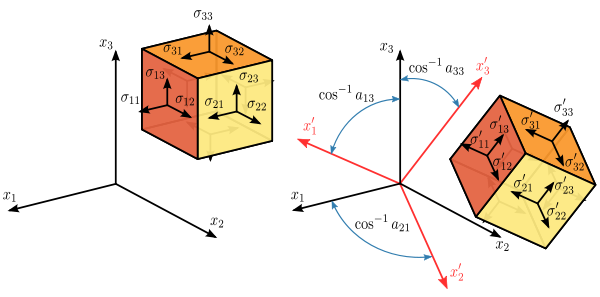






The Mohr circle for stress is a graphical representation of this transformation of stresses.
Normal and shear stresses
The magnitude of the normalTangential and normal components
In mathematics, given a vector at a point on a curve, that vector can be decomposed uniquely as a sum of two vectors, one tangent to the curve, called the tangential component of the vector, and another one perpendicular to the curve, called the normal component of the vector...
stress component σn of any stress vector T(n) acting on an arbitrary plane with normal vector n at a given point, in terms of the components σij of the stress tensor σ, is the dot product
Dot product
In mathematics, the dot product or scalar product is an algebraic operation that takes two equal-length sequences of numbers and returns a single number obtained by multiplying corresponding entries and then summing those products...
of the stress vector and the normal vector:

The magnitude of the shear stress component τn, acting in the plane spanned by the two vectors T(n) and n, can then be found using the Pythagorean theorem
Pythagorean theorem
In mathematics, the Pythagorean theorem or Pythagoras' theorem is a relation in Euclidean geometry among the three sides of a right triangle...
:

where

Equilibrium equations and symmetry of the stress tensor
When a body is in equilibrium the components of the stress tensor in every point of the body satisfy the equilibrium equations,
For example, for a hydrostatic fluid
Hydrostatic fluid
In atmospheric dynamics and fluid dynamics, a hydrostatic fluid is a fluid in which fluid stresses act isotropically and fluid elements are in local equilibrium with one another...
in equilibrium conditions, the stress tensor
Stress tensor
Stress tensor may refer to:* Stress , in classical physics* Stress-energy tensor, in relativistic theories* Maxwell stress tensor, in electromagnetism...
takes on the form:
 ,
,where
 is the hydrostatic pressure, and
is the hydrostatic pressure, and  is the kronecker delta.
is the kronecker delta.| Derivation of equilibrium equations |
|---|
Consider a continuum body (see Figure 4) occupying a volume  , having a surface area , having a surface area  , with defined traction or surface forces , with defined traction or surface forces  per unit area acting on every point of the body surface, and body forces per unit area acting on every point of the body surface, and body forces  per unit of volume on every point within the volume per unit of volume on every point within the volume  . Thus, if the body is in equilibrium the resultant force acting on the volume is zero, thus: . Thus, if the body is in equilibrium the resultant force acting on the volume is zero, thus: By definition the stress vector is  , then , then Using the Gauss's divergence theorem Divergence theorem In vector calculus, the divergence theorem, also known as Gauss' theorem , Ostrogradsky's theorem , or Gauss–Ostrogradsky theorem is a result that relates the flow of a vector field through a surface to the behavior of the vector field inside the surface.More precisely, the divergence theorem... to convert a surface integral to a volume integral gives   For an arbitrary volume the integral vanishes, and we have the equilibrium equations  |
At the same time, equilibrium requires that the summation of moments with respect to an arbitrary point is zero, which leads to the conclusion that the stress tensor is symmetric, i.e.

| Derivation of symmetry of the stress tensor |
|---|
Summing moments about point O (Figure 4) the resultant moment is zero as the body is in equilibrium. Thus, where  is the position vector and is expressed as is the position vector and is expressed as Knowing that  and using Gauss's divergence theorem to change from a surface integral to a volume integral, we have and using Gauss's divergence theorem to change from a surface integral to a volume integral, we have The second integral is zero as it contains the equilibrium equations. This leaves the first integral, where  , therefore , therefore For an arbitrary volume V, we then have  which is satisfied at every point within the body. Expanding this equation we have  , ,  , and , and  or in general  This proves that the stress tensor is symmetric |
However, in the presence of couple-stresses, i.e. moments per unit volume, the stress tensor is non-symmetric. This also is the case when the Knudsen number
Knudsen number
The Knudsen number is a dimensionless number defined as the ratio of the molecular mean free path length to a representative physical length scale. This length scale could be, for example, the radius of a body in a fluid...
is close to one,
 , or the continuum is a non-Newtonian fluid, which can lead to rotationally non-invariant fluids, such as polymers.
, or the continuum is a non-Newtonian fluid, which can lead to rotationally non-invariant fluids, such as polymers.Principal stresses and stress invariants
At every point in a stressed body there are at least three planes, called principal planes, with normal vectors , called principal directions, where the corresponding stress vector is perpendicular to the plane, i.e., parallel or in the same direction as the normal vector
, called principal directions, where the corresponding stress vector is perpendicular to the plane, i.e., parallel or in the same direction as the normal vector  , and where there are no normal shear stresses
, and where there are no normal shear stresses  . The three stresses normal to these principal planes are called principal stresses.
. The three stresses normal to these principal planes are called principal stresses.The components
 of the stress tensor depend on the orientation of the coordinate system at the point under consideration. However, the stress tensor itself is a physical quantity and as such, it is independent of the coordinate system chosen to represent it. There are certain invariants
of the stress tensor depend on the orientation of the coordinate system at the point under consideration. However, the stress tensor itself is a physical quantity and as such, it is independent of the coordinate system chosen to represent it. There are certain invariantsInvariant (physics)
In mathematics and theoretical physics, an invariant is a property of a system which remains unchanged under some transformation.-Examples:In the current era, the immobility of polaris under the diurnal motion of the celestial sphere is a classical illustration of physical invariance.Another...
associated with every tensor which are also independent of the coordinate system. For example, a vector is a simple tensor of rank one. In three dimensions, it has three components. The value of these components will depend on the coordinate system chosen to represent the vector, but the length
Length
In geometric measurements, length most commonly refers to the longest dimension of an object.In certain contexts, the term "length" is reserved for a certain dimension of an object along which the length is measured. For example it is possible to cut a length of a wire which is shorter than wire...
of the vector is a physical quantity (a scalar) and is independent of the coordinate system chosen to represent the vector. Similarly, every second rank tensor (such as the stress and the strain tensors) has three independent invariant quantities associated with it. One set of such invariants are the principal stresses of the stress tensor, which are just the eigenvalues of the stress tensor. Their direction vectors are the principal directions or eigenvectors.
A stress vector parallel to the normal vector
 is given by:
is given by:
where
 is a constant of proportionality, and in this particular case corresponds to the magnitudes
is a constant of proportionality, and in this particular case corresponds to the magnitudes  of the normal stress vectors or principal stresses.
of the normal stress vectors or principal stresses.Knowing that
 and
and  , we have
, we have
This is a homogeneous system, i.e. equal to zero, of three linear equations where
 are the unknowns. To obtain a nontrivial (non-zero) solution for
are the unknowns. To obtain a nontrivial (non-zero) solution for  , the determinant matrix of the coefficients must be equal to zero, i.e. the system is singular. Thus,
, the determinant matrix of the coefficients must be equal to zero, i.e. the system is singular. Thus,
Expanding the determinant leads to the characteristic equation

where
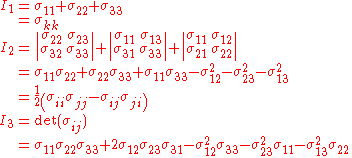
The characteristic equation has three real roots
 , i.e. not imaginary due to the symmetry of the stress tensor. The
, i.e. not imaginary due to the symmetry of the stress tensor. The  ,
,  and
and  , are the principal stresses, functions of the eigenvalues
, are the principal stresses, functions of the eigenvalues  . The eigenvalues are the roots of the Cayley–Hamilton theorem
. The eigenvalues are the roots of the Cayley–Hamilton theoremCayley–Hamilton theorem
In linear algebra, the Cayley–Hamilton theorem states that every square matrix over a commutative ring satisfies its own characteristic equation....
. The principal stresses are unique for a given stress tensor. Therefore, from the characteristic equation, the coefficients
 ,
,  and
and  , called the first, second, and third stress invariants, respectively, have always the same value regardless of the coordinate system's orientation.
, called the first, second, and third stress invariants, respectively, have always the same value regardless of the coordinate system's orientation.For each eigenvalue, there is a non-trivial solution for
 in the equation
in the equation  . These solutions are the principal directions or eigenvectors defining the plane where the principal stresses act. The principal stresses and principal directions characterize the stress at a point and are independent of the orientation.
. These solutions are the principal directions or eigenvectors defining the plane where the principal stresses act. The principal stresses and principal directions characterize the stress at a point and are independent of the orientation.A coordinate system with axes oriented to the principal directions implies that the normal stresses are the principal stresses and the stress tensor is represented by a diagonal matrix:

The principal stresses can be combined to form the stress invariants,
 ,
,  , and
, and  . The first and third invariant are the trace and determinant respectively, of the stress tensor. Thus,
. The first and third invariant are the trace and determinant respectively, of the stress tensor. Thus,
Because of its simplicity, the principal coordinate system is often useful when considering the state of the elastic medium at a particular point. Principal stresses are often expressed in the following equation for evaluating stresses in the x and y directions or axial and bending stresses on a part. The principal normal stresses can then be used to calculate the von Mises stress
Von Mises stress
The von Mises yield criterion suggests that the yielding of materials begins when the second deviatoric stress invariant J_2 reaches a critical value k. For this reason, it is sometimes called the J_2-plasticity or J_2 flow theory. It is part of a plasticity theory that applies best to ductile...
and ultimately the safety factor and margin of safety.

Using just the part of the equation under the square root
Square root
In mathematics, a square root of a number x is a number r such that r2 = x, or, in other words, a number r whose square is x...
is equal to the maximum and minimum shear stress for plus and minus. This is shown as:

Maximum and minimum shear stresses
The maximum shear stress or maximum principal shear stress is equal to one-half the difference between the largest and smallest principal stresses, and acts on the plane that bisects the angle between the directions of the largest and smallest principal stresses, i.e. the plane of the maximum shear stress is oriented from the principal stress planes. The maximum shear stress is expressed as
from the principal stress planes. The maximum shear stress is expressed as
Assuming
 then
then
The normal stress component acting on the plane for the maximum shear stress is non-zero and it is equal to

| Derivation of the maximum and minimum shear stresses |
|---|
as Knowing that  , the shear stress in terms of principal stresses components is expressed as , the shear stress in terms of principal stresses components is expressed as The maximum shear stress at a point in a continuum body is determined by maximizing  subject to the condition that subject to the condition that This is a constrained maximization problem, which can be solved using the Lagrangian multiplier technique to convert the problem into an unconstrained optimization problem. Thus, the stationary values (maximum and minimum values)of  occur where the gradient of occur where the gradient of  is parallel to the gradient of is parallel to the gradient of  . .The Lagrangian function for this problem can be written as  where  is the Lagrangian multiplier (which is different from the is the Lagrangian multiplier (which is different from the  use to denote eigenvalues). use to denote eigenvalues).The extreme values of these functions are  thence    These three equations together with the condition  may be solved for may be solved for  and and  By multiplying the first three equations by  and and  , respectively, and knowing that , respectively, and knowing that  we obtain we obtain   Adding these three equations we get  this result can be substituted into each of the first three equations to obtain  Doing the same for the other two equations we have   A first approach to solve these last three equations is to consider the trivial solution  . However this options does not fulfill the constrain . However this options does not fulfill the constrain  . .Considering the solution where  and and  , it is determine from the condition , it is determine from the condition  that that  , then from the original equation for , then from the original equation for  it is seen that it is seen that  . .The other two possible values for  can be obtained similarly by assuming can be obtained similarly by assuming and and   and and  Thus, one set of solutions for these four equations is:  These correspond to minimum values for  and verifies that there are no shear stresses on planes normal to the principal directions of stress, as shown previously. and verifies that there are no shear stresses on planes normal to the principal directions of stress, as shown previously.A second set of solutions is obtained by assuming  and and  . Thus we have . Thus we have  To find the values for  and and  we first add these two equations we first add these two equations Knowing that for   and  we have  and solving for  we have we have Then solving for  we have we have and  The other two possible values for  can be obtained similarly by assuming can be obtained similarly by assuming and and   and and  Therefore the second set of solutions for  , representing a maximum for , representing a maximum for  is is   Therefore, assuming  , the maximum shear stress is expressed by , the maximum shear stress is expressed by and it can be stated as being equal to one-half the difference between the largest and smallest principal stresses, acting on the plane that bisects the angle between the directions of the largest and smallest principal stresses. |
Stress deviator tensor
The stress tensor can be expressed as the sum of two other stress tensors:
can be expressed as the sum of two other stress tensors:
- a mean hydrostatic stressHydrostatic stressIn continuum mechanics, a hydrostatic stress is an isotropic stress that is given by the weight of water above a certain point. It is often used interchangeably with "pressure" and is also known as confining stress, particularly in the field geomechanics...
tensor or volumetric stress tensor or mean normal stress tensor, , which tends to change the volume of the stressed body; and
, which tends to change the volume of the stressed body; and - a deviatoric component called the stress deviator tensor,
 , which tends to distort it.
, which tends to distort it.
So:

where
 is the mean stress given by
is the mean stress given by
Note that convention in solid mechanics differs slightly from what is listed above. In solid mechanics, pressure is generally defined as negative one-third the trace of the stress tensor.
The deviatoric stress tensor can be obtained by subtracting the hydrostatic stress tensor from the stress tensor:
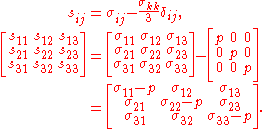
Invariants of the stress deviator tensor
As it is a second order tensor, the stress deviator tensor also has a set of invariantsInvariants of tensors
In mathematics, in the fields of multilinear algebra and representation theory, invariants of tensors are coefficients of the characteristic polynomial of the tensor A:\ p:=\det ,...
, which can be obtained using the same procedure used to calculate the invariants of the stress tensor. It can be shown that the principal directions of the stress deviator tensor
 are the same as the principal directions of the stress tensor
are the same as the principal directions of the stress tensor  . Thus, the characteristic equation is
. Thus, the characteristic equation is
where
 ,
,  and
and  are the first, second, and third deviatoric stress invariants, respectively. Their values are the same (invariant) regardless of the orientation of the coordinate system chosen. These deviatoric stress invariants can be expressed as a function of the components of
are the first, second, and third deviatoric stress invariants, respectively. Their values are the same (invariant) regardless of the orientation of the coordinate system chosen. These deviatoric stress invariants can be expressed as a function of the components of  or its principal values
or its principal values  ,
,  , and
, and  , or alternatively, as a function of
, or alternatively, as a function of  or its principal values
or its principal values  ,
,  , and
, and  . Thus,
. Thus,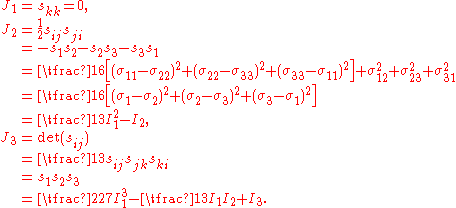
Because
 , the stress deviator tensor is in a state of pure shear.
, the stress deviator tensor is in a state of pure shear.A quantity called the equivalent stress or von Mises stress is commonly used in solid mechanics. The equivalent stress is defined as

Octahedral stresses
Considering the principal directions as the coordinate axes, a plane whose normal vector makes equal angles with each of the principal axes (i.e. having direction cosines equal to ) is called an octahedral plane. There are a total of eight octahedral planes (Figure 6). The normal and shear components of the stress tensor on these planes are called octahedral normal stress
) is called an octahedral plane. There are a total of eight octahedral planes (Figure 6). The normal and shear components of the stress tensor on these planes are called octahedral normal stress  and octahedral shear stress
and octahedral shear stress  , respectively.
, respectively.Knowing that the stress tensor of point O (Figure 6) in the principal axes is

the stress vector on an octahedral plane is then given by:

The normal component of the stress vector at point O associated with the octahedral plane is

which is the mean normal stress or hydrostatic stress. This value is the same in all eight octahedral planes.
The shear stress on the octahedral plane is then

Alternative measures of stress
Other useful stress measures include the first and second Piola–Kirchhoff stress tensors, the Biot stress tensorStress measures
The most commonly used measure of stress is the Cauchy stress. However, several other measures of stress can be defined. Some such stress measures that are widely used in continuum mechanics, particularly in the computational context, are:...
, and the Kirchhoff stress tensor
Stress measures
The most commonly used measure of stress is the Cauchy stress. However, several other measures of stress can be defined. Some such stress measures that are widely used in continuum mechanics, particularly in the computational context, are:...
.
Piola–Kirchhoff stress tensor
In the case of finite deformations, the Piola–Kirchhoff stress tensors express the stress relative to the reference configuration. This is in contrast to the Cauchy stress tensor which expresses the stress relative to the present configuration. For infinitesimal deformations or rotations, the Cauchy and Piola–Kirchhoff tensors are identical.Whereas the Cauchy stress tensor,
 relates stresses in the current configuration, the deformation gradient
relates stresses in the current configuration, the deformation gradientGradient
In vector calculus, the gradient of a scalar field is a vector field that points in the direction of the greatest rate of increase of the scalar field, and whose magnitude is the greatest rate of change....
and strain tensors are described by relating the motion to the reference configuration; thus not all tensors describing the state of the material are in either the reference or current configuration. Describing the stress, strain and deformation either in the reference or current configuration would make it easier to define constitutive models (for example, the Cauchy Stress tensor is variant to a pure rotation, while the deformation strain tensor is invariant; thus creating problems in defining a constitutive model that relates a varying tensor, in terms of an invariant one during pure rotation; as by definition constitutive models have to be invariant to pure rotations). The 1st Piola–Kirchhoff stress tensor,
 is one possible solution to this problem. It defines a family of tensors, which describe the configuration of the body in either the current or the reference state.
is one possible solution to this problem. It defines a family of tensors, which describe the configuration of the body in either the current or the reference state.The 1st Piola–Kirchhoff stress tensor,
 relates forces in the present configuration with areas in the reference ("material") configuration.
relates forces in the present configuration with areas in the reference ("material") configuration.
where
 is the deformation gradient and
is the deformation gradient and  is the Jacobian determinant
is the Jacobian determinantDeterminant
In linear algebra, the determinant is a value associated with a square matrix. It can be computed from the entries of the matrix by a specific arithmetic expression, while other ways to determine its value exist as well...
.
In terms of components with respect to an orthonormal basis
Orthonormal basis
In mathematics, particularly linear algebra, an orthonormal basis for inner product space V with finite dimension is a basis for V whose vectors are orthonormal. For example, the standard basis for a Euclidean space Rn is an orthonormal basis, where the relevant inner product is the dot product of...
, the first Piola–Kirchhoff stress is given by

Because it relates different coordinate systems, the 1st Piola–Kirchhoff stress is a two-point tensor
Two-point tensor
Two-point tensors, or double vectors, are tensor-like quantities which transform as vectors with respect to each of their indices and are used in continuum mechanics to transform between reference and present coordinates...
. In general, it is not symmetric. The 1st Piola–Kirchhoff stress is the 3D generalization of the 1D concept of engineering stress.
If the material rotates without a change in stress state (rigid rotation), the components of the 1st Piola–Kirchhoff stress tensor will vary with material orientation.
The 1st Piola–Kirchhoff stress is energy conjugate to the deformation gradient.
2nd Piola–Kirchhoff stress tensor
Whereas the 1st Piola–Kirchhoff stress relates forces in the current configuration to areas in the reference configuration, the 2nd Piola–Kirchhoff stress tensor relates forces in the reference configuration to areas in the reference configuration. The force in the reference configuration is obtained via a mapping that preserves the relative relationship between the force direction and the area normal in the current configuration.
relates forces in the reference configuration to areas in the reference configuration. The force in the reference configuration is obtained via a mapping that preserves the relative relationship between the force direction and the area normal in the current configuration.
In index notation
Index notation
Index notation is used in mathematics and computer programming to specify the elements of matrices or the components of a vector. The formalism of how indices are used varies according to the discipline...
with respect to an orthonormal basis,

This tensor is symmetric.
If the material rotates without a change in stress state (rigid rotation), the components of the 2nd Piola–Kirchhoff stress tensor remain constant, irrespective of material orientation.
The 2nd Piola–Kirchhoff stress tensor is energy conjugate to the Green–Lagrange finite strain tensor.
Further reading
- Dieter, G. E. (3 ed.). (1989). Mechanical Metallurgy. New York: McGraw-Hill. ISBN 0-07-100406-8.
- Landau, L.D. and E.M.Lifshitz. (1959). Theory of Elasticity.
- Love, A. E. H. (4 ed.). (1944). Treatise on the Mathematical Theory of Elasticity. New York: Dover Publications. ISBN 0-486-60174-9.

